Qualcomm Snapdragon 805 Performance Preview
by Anand Lal Shimpi on May 21, 2014 8:00 PM EST- Posted in
- Tablets
- Snapdragon
- Qualcomm
- Mobile
- SoCs
- Snapdragon 805
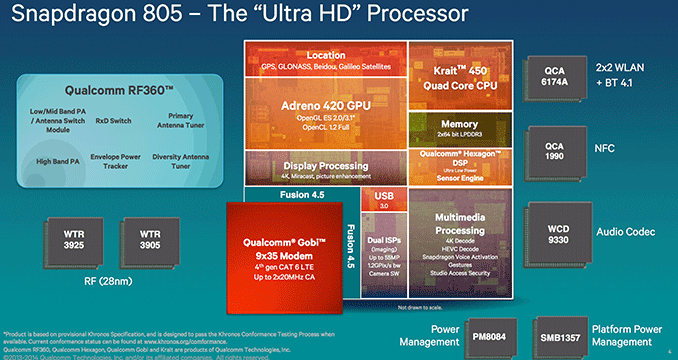
Last year Qualcomm announced a new tier in its high end SoC roadmap with the Snapdragon 805. Priced somewhat above the current Snapdragon 800/801, the 805 would be the last 32-bit high-end SoC from Qualcomm. It would be the grand finale in Krait's lineage, which started back in 2012 with Krait 200 and MSM8960 and saw iterative improvements over the years. The Snapdragon 805 was not only designed to drive CPU performance higher but also be the launch vehicle for Qualcomm's brand new Adreno 4xx GPU architecture.
The Snapdragon 805 SoC is a beast. It features four Krait 450 cores, each a mild tweak of the Krait 400 design used in the S800/801. These cores can now run at up to 2.7GHz compared to 2.5GHz in the Snapdragon 801 (Krait 400). As always, Qualcomm advertises customer-friendly frequencies rounded up to the nearest 100MHz, the actual max frequency of each Krait 450 core is 2.65GHz (compared to 2.45GHz in Krait 400).
The 8% increase in max frequency comes from tuning at the circuit level, there's no impact to IPC. All four cores sit behind a shared 2MB L2 cache. As is the case with all multi-core Krait SoCs, each CPU core can be power gated, clock gated and even clocked independently of the rest.
The S805 features Qualcomm's Adreno 420 GPU with full support for OpenGL ES 3.1 (with some extensions), OpenCL 1.2 and Direct3D feature level 11_2 (with a hardware tessellation engine). In typical Qualcomm fashion, it isn't disclosing any material details on the underlying Adreno 420 architecture so we'll have to guess based on what the benchmarks tell us. Adreno 420 includes support for Adaptive Scalable Texture Compression (ASTC), a new texture compression first introduced by ARM in 2011.
There are other architectural improvements including better texturing performance and faster depth rejection. The architecture should be more efficient than Adreno 3xx as well, making better use of the underlying hardware.
The GPU runs at a max frequency of 600MHz.
Qualcomm claims a 20% reduction in power consumption compared to Adreno 330 (Snapdragon 800) when running the T-Rex HD test from GFXBench at 1080p (onscreen).
For the first time, the GPU now gets its own direct path to the SoC's memory interface. In the past the GPU shared a bus with the ISP and video engines, but in order to feed the beast that had to change. The memory interface on S805 features two 64-bit LPDDR3-800 partitions (4 x 32-bit external interfaces), each capable of supporting 1600MHz datarate LPDDR3 for an aggregate peak theoretical bandwidth figure of 25.6GB/s. The Krait 450 cores themselves aren't big enough to use all of that memory bandwidth. The wide memory interface is really there for the GPU and video engines. We haven't seen a memory interface this wide on a mobile SoC since Apple's A5X/A6X designs.
In order to accommodate the wider memory interface but still make Snapdragon 805 suitable for use in a smartphone as well as a tablet, Qualcomm turned to a different packaging technology. Since the Snapdragon 805 is an APQ part, it lacks the integrated modem of the MSM SoCs we've found in most of Qualcomm's recent flagships. S805 uses a Moulded Embedded Package (MEP) that allows Qualcomm to route its 128-bit wide memory interface to on-package DRAM, giving it all of the benefits of a PoP stack as well as the wider memory interface. Qualcomm wouldn't provide me with a ton of details on MEP other than to say that rather than using the perimeter of the SoC's package to connect to memory stacked above it, MEP uses a substrate layer on top of the SoC to connect to the memory, giving the SoC more surface area to route lines to the DRAM. Qualcomm also claims the amount of metal it uses in the DRAM's substrate layer has some small impact on improving thermals on the overall package. The result is that Snapdragon 805 is still compact enough to go into a smartphone as long as the design can accomodate a discrete modem.
The Snapdragon 805 also marks Qualcomm's first SoC with a hardware H.265/HEVC video decode engine. There's no hardware H.265 encode acceleration however, that won't come until Snapdragon 810 in 2015.
The S805's ISP sees an increase in performance as well. The SoC retains Qualcomm's dual-ISP design, now capable of pushing up to 1.2 Gigapixels/s through the engine. If Qualcomm arrives at that number the same way as it has in the past, that would imply a 600MHz ISP operating frequency (up from 465MHz in the Snapdragon 801). The new ISP supports up to four MIPI camera inputs (TrioCam + FF anyone?). The ISP can support 4k30 and 1080p120 video capture.
Qualcomm also claims improved autofocus performance and better noise reduction.
Just as in years past, Qualcomm invited us out to a benchmarking workshop to get some hands on time with its Snapdragon 805 Mobile Development Platform (MDP) ahead of actual device availability. And just like we saw with the Snapdragon 800 benchmarking workshop, the S805's MDP comes in tablet form.the Snapdragon 805 MDP/T features a 10.6" 2560 x 1440 display, 3GB of LPDDR3 memory and 64GB of internal storage (eMMC 5.0). The chassis looks very similar to previous MDP/T designs.
Just as before, the benchmarks that follow are of a pre-production device that isn't shipping hardware. Although Qualcomm has significantly improved the delta we've seen between MDPs and shipping devices, there's always the caveat that performance could be different once we are looking at a shipping device, running on battery power. Although Qualcomm gave us access to the MDP/T, the devices were running on AC power with no power instrumentation connected. Qualcomm's own data shows a reduction in power consumption for Snapdragon 805 vs. 800, but once again we'll have to wait for shipping devices to really understand the impact of the SoC on battery life. What follows is exactly what the title of this piece indicates: a preview of Snapdragon 805 performance. Although Qualcomm pre-loaded the MDP/T with some commonly used benchmarks, we installed our own copies of everything we ran.
| Qualcomm's Snapdragon 8xx Lineup | |||||||
| Snapdragon 810 | Snapdragon 808 | Snapdragon 805 | Snapdragon 801 | Snapdragon 800 | |||
| Internal Model Number | MSM8994 | MSM8992 | APQ8084 | MSM8974 v3 | MSM8974 v2 | ||
| Manufacturing Process | 20nm | 20nm | 28nm HPm | 28nm HPm | 28nm HPm | ||
| CPU | 4 x ARM Cortex A57 + 4 x ARM Cortex A53 (big.LITTLE) | 2 x ARM Cortex A57 + 4 x ARM Cortex A53 (big.LITTLE) | 4 x Qualcomm Krait 450 | 4 x Qualcomm Krait 400 | 4 x Qualcomm Krait 400 | ||
| ISA | 32/64-bit ARMv8-A | 32/64-bit ARMv8-A | 32-bit ARMv7-A | 32-bit ARMv7-A | 32-bit ARMv7-A | ||
| GPU | Adreno 430 | Adreno 418 | Adreno 420 | Adreno 330 | Adreno 330 | ||
| H.265 Decode | Yes | Yes | Yes | No | No | ||
| H.265 Encode | Yes | No | No | No | No | ||
| Memory Interface | 2 x 32-bit LPDDR4-1600 | 2 x 32-bit LPDDR3-933 | 4 x 32-bit LPDDR3-800 | 2 x 32-bit LPDDR3-800/933 | 2 x 32-bit LPDDR3-800/933 | ||
| Integrated Modem | 9x35 core, LTE Category 6/7, DC-HSPA+, DS-DA | 9x35 core, LTE Category 6/7, DC-HSPA+, DS-DA | - | 9x25 core, LTE Category 4, DC-HSPA+, DS-DA | 9x25 core, LTE Category 4, DC-HSPA+, DS-DA | ||
| Integrated WiFi | - | - | - | - | - | ||
| eMMC Interface | 5.0 | 5.0 | 5.0 | 5.0 | 4.5 | ||
| Camera ISP | 14-bit dual-ISP | 12-bit dual-ISP | 1.2 GP/s | 930 MP/s | 640 MP/s | ||
| Shipping in Devices | 1H 2015 | 1H 2015 | 2H 2014 | Now | Now | ||
I pulled comparison results from our new combined Phone/Tablet 2014 category in Bench. The key comparisons here are the iPad Air (for obvious reasons), ASUS' Transformer Pad TF701T (Tegra 4 in a tablet), ASUS' Transformer Book T100 (Intel's Bay Trail in a tablet) and the HTC One (M8)/Samsung Galaxy S 5 (both are Snapdragon 801 devices). With the exception of the Bay Trail based T100, everything else runs iOS or Android.



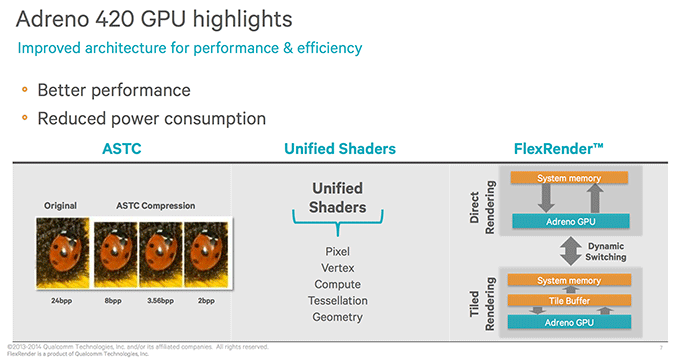
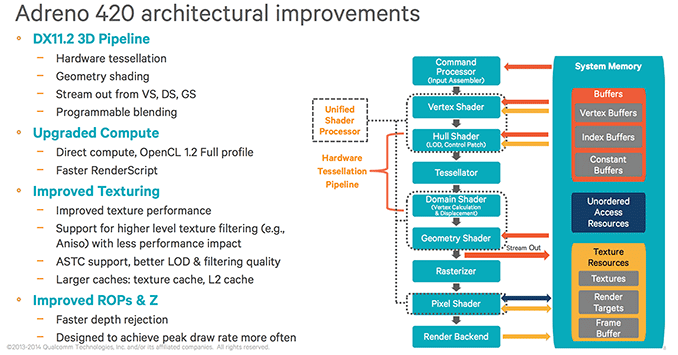
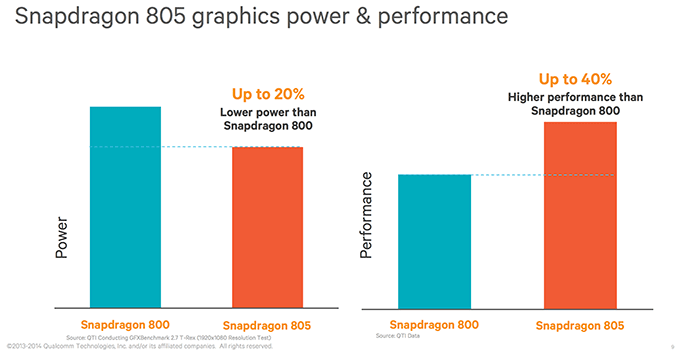
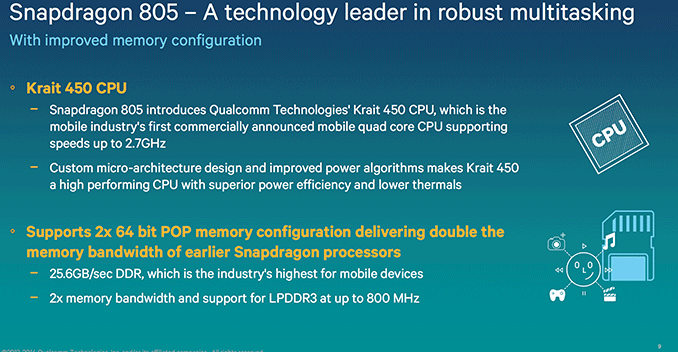
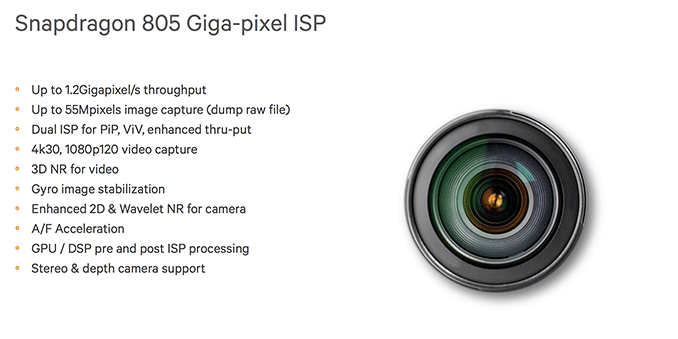
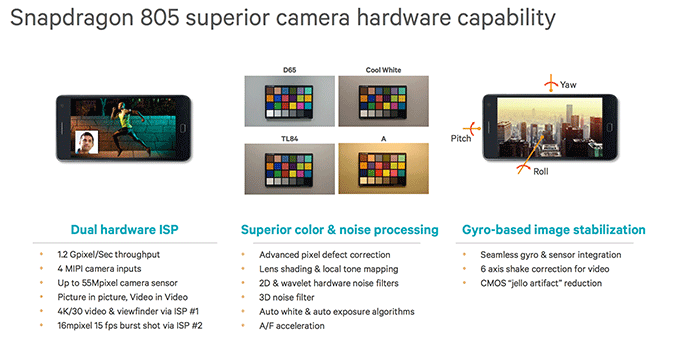

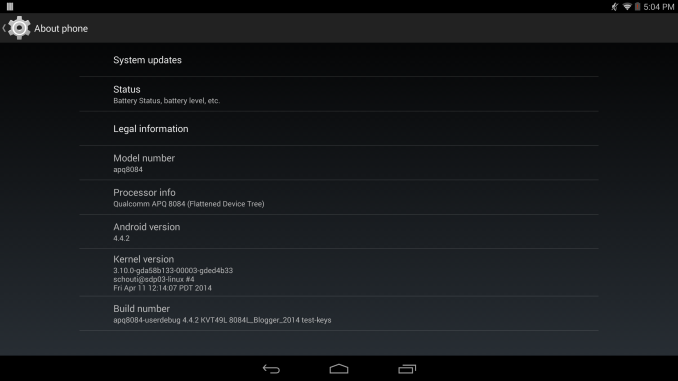








149 Comments
View All Comments
testbug00 - Thursday, May 22, 2014 - link
Yeah, it supports DX11.2.... no other mobile GPU supports... Wait. Qualcomm does... And I wonder how long until ARM "stock" GPU does... And Imagine Tech's...Nvidia is not displacing Qualcomm most likely. It could happen, but, given OEM relationships, it is unlikely. Even if NVidia has a better product (note: I think they have one that is on best even with Qualcomm (for Phones)) the OEM relations mean a lot. ATI managed to make quite a bit of money despite NVidia having far better products due to OEM relationships.
kron123456789 - Thursday, May 22, 2014 - link
"Yeah, it supports DX11.2.... no other mobile GPU supports... Wait. Qualcomm does... And I wonder how long until ARM "stock" GPU does... And Imagine Tech's..." — Only Tegra K1 supports OpenGL 4.4. DirectX support matters ONLY on Windows. And Tegra K1 supports DirectX 12(because of that: http://blogs.nvidia.com/blog/2014/03/20/directx-12... ).tuxRoller - Friday, May 23, 2014 - link
Why does opengl 4.4 matter? Who would consume it?http://richg42.blogspot.com/2014/05/the-truth-on-o...
fivefeet8 - Friday, May 23, 2014 - link
Unfortunately, OpenGL 4.x will mean little to Android devices until Qualcomm starts actually caring about the API in their drivers. If the K1 actually competes in tablets and superphones, it may actually have the effect of forcing them to through competition.https://dolphin-emu.org/blog/2013/09/26/dolphin-em...
tuxRoller - Friday, May 23, 2014 - link
Look, you don't need to keep linking to that old post. I'm don't need to argue about adreno blob quality. Nvidia, however, lives and breathes on it software, which seems to be not quite as flawless as some would believe.Again, why does gl matter to android? It doesn't even support it. The point of having the embedded profile is to expose enough of gl to create a good balance between high performance/graphics quality and efficiency. Going full blown gl destroys that last advantage (tesselation alone is terrible for battery life).
kron123456789 - Friday, May 23, 2014 - link
Serious Sam 3 for Tegra K1 is using OpenGL 4(and Croteam have Android build that supports OpenGL 4).tuxRoller - Friday, May 23, 2014 - link
Great, but you aren't going to see Google including gl in their builds. The reason? Gles is the best of what can be supported while maintaining decent battery.fivefeet8 - Thursday, May 22, 2014 - link
Hardware level support for API's mean diddly squat if their drivers are crap. My Galaxy S4 with the Snapdragon 600 supports OpenGLes3, but it sucks at it. Nvidia actually has a history of nominal OpenGL support in drivers at least.ams23 - Thursday, May 22, 2014 - link
Who said anything about NVIDIA "displacing" Qualcomm? That is pure silliness. NVIDIA offers a "differentiated" product. Any OEM who wants to offer differentiated high end products may consider using Tegra K1. K1 is also a very versatile product, so it will be used in a wide variety of different products.ams23 - Thursday, May 22, 2014 - link
Companies like Xiaomi that are looking for differentiated products would absolutely consider using Tegra K1 in a high end smartphone. Considering the performance and perf. per watt advantages for Tegra K1, there are clearly compelling reasons to use it. But again, like I said above, the lions share of phones outside of Apple and Samsung will go to Qualcomm (bundled modem) and Mediatek (lowest cost).